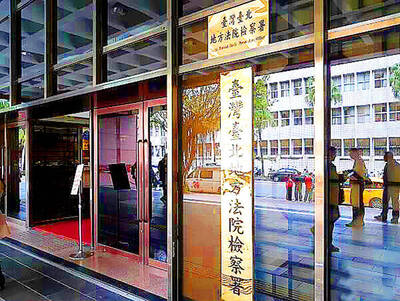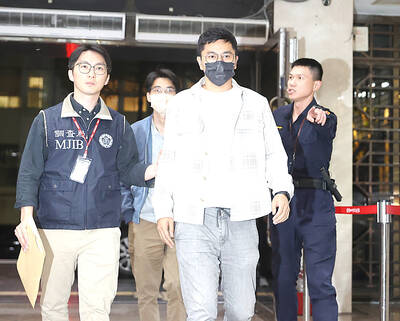Japan is sending 100 soldiers and radar equipment to its westernmost outpost, a tropical island off Taiwan, in a deployment that risks angering China with ties between Asia’s biggest economies already hurt by a dispute over nearby islands they both claim.
Japanese Minister of Defense Itsunori Onodera is to break ground today for a military lookout station on Yonaguni, which is home to 1,500 people and just 150km from disputed Japanese-held islands claimed by Taiwan and China.
The mini-militarization of Yonaguni — now defended by two police officers — is part of a longstanding plan to improve defense and surveillance in Japan’s far-flung frontier.
Building the radar base on the island, which is much closer to China than to Japan’s main islands, could extend Japanese monitoring to the Chinese mainland, and track Chinese ships and aircraft circling the disputed crags, called the Senkakus by Japan and the Diaoyutais (釣魚台) by Taiwan.
“We decided to deploy a Ground Self-Defense Force unit on Yonaguni Island as a part of our effort to strengthen the surveillance over the southwestern region,” Onodera said this week. “We are staunchly determined to protect Yonaguni Island, a part of the precious Japanese territory.”
The 30km2 backwater — known for strong rice liquor, cattle, sugarcane and scuba diving — may seem an unlikely place for Japanese Prime Minister Shinzo Abe to put boots on the ground.
However, Yonaguni marks the confluence of the Japanese defense establishment’s concerns about the vulnerability of the country’s thousands of islands and the perceived threat from China.
The new base “should give Japan the ability to expand surveillance to near the Chinese mainland,” said Heigo Sato, a professor at Takushoku University and a former researcher at the defense ministry’s National Institute for Defense Studies.
“It will allow early warning of missiles and supplement the monitoring of Chinese military movements,” Sato said.
Japan does not specify an enemy when discussing its strategy to defend its remote islands, but it makes no secret that it perceives China generally as a threat — a giant flexing its growing muscle and becoming an Asian military power to rival Japan’s ally, the US, in the region.
Japan, in National Defense Program Guidelines issued in December, expressed “great concern” over China’s rapid military buildup, opaque security goals, its “attempts to change the status quo by coercion” in the sea and air, and such “dangerous activities” as last year’s announcement of an air-defense identification zone.
Japan’s remote-island strategy, set out in the guidelines, is to “intercept and defeat any invasion by securing maritime supremacy and air superiority” with swift deployments supplementing troops positioned in advance.
“Should any remote islands be invaded, Japan will recapture them. In doing so, any ballistic missile or cruise missile attacks will be dealt with appropriately,” the guidelines say.
Yonaguni, at the western tip of Japan’s 3,300km southwestern island chain, is practically within sight of the disputed rocks that are the feared flashpoint of Japan’s island strategy, which could draw the US into a fight.
Onodera’s groundbreaking ceremony comes four days before US President Barack Obama lands in Tokyo for a summit with Abe, the first state visit by a US president in 18 years.
Japanese and Chinese navy and coast guard ships have played high-stakes cat and mouse around the disputed islets since Japan nationalized the formerly privately owned territory in September 2012. Japanese fighter jets scrambled against Chinese planes a record 415 times in the year through last month, up 36 percent from the previous year, the Japanese Ministry of Defense said last week.
Tapping such concerns, Abe raised military spending last fiscal year for the first time in 11 years.
He is bolstering Japan’s capability to fight for islands with a new marine unit, more longer-range aircraft, amphibious assault vehicles and helicopter carriers. Although the country’s landmass is smaller than California, its thousands of islands give it nearly 30,000km of coastline to defend.
However, tight fiscal constraints mean Japan cannot keep pace with China’s yearly double-digit military budget increases.
The people of Yonaguni, where Abe wants to station 100 troops and perhaps as many family members within two years, have mixed feelings about their imminent role in facing off against China.
“Opinion is split down the middle,” Tetsuo Funamichi, the head of the island’s branch of the Japan Agricultural Association, said by telephone. “It’s good for the economy if they come, but some people worry that we could be attacked in an emergency.”
Takenori Komine, who works in an island government office, said it was a risk worth taking if it meant reviving an outpost of Japan that has been in decline since a brief postwar boom.
At that time, US-occupied Yonaguni’s proximity to Taiwan made it an entry point into Japan for smuggled food and clothing from Hong Kong. Since the end of World War II, the island’s population has withered by about 90 percent. Average income of about US$22,500 a year is a fifth below the national average.
“We are hopeful that the arrival of the young troops will bolster local consumption,” Komine said.
However, Yonaguni’s mainstays — beef and sugarcane — are in the crosshairs of trade negotiations. Abe is trying to defend Japan’s high tariffs on them, but has recently agreed to beef tariff cuts for Australia and is under strong pressure to do the same for the US before Obama’s visit, as part of broad talks on an ambitious Trans-Pacific Partnership (TPP) trade pact.
“If the TPP includes sugar, this island is finished,” Funamichi said.
And a sharply falling population on Yonaguni would have security implications, a government official said.
“It’s not good from the perspective of securing our territory,” the official in Tokyo said. “If people don’t live there, you could lose your claim to effective control.”

INVESTIGATION: The case is the latest instance of a DPP figure being implicated in an espionage network accused of allegedly leaking information to Chinese intelligence Democratic Progressive Party (DPP) member Ho Jen-chieh (何仁傑) was detained and held incommunicado yesterday on suspicion of spying for China during his tenure as assistant to then-minister of foreign affairs Joseph Wu (吳釗燮). The Taipei District Prosecutors’ Office said Ho was implicated during its investigation into alleged spying activities by former Presidential Office consultant Wu Shang-yu (吳尚雨). Prosecutors said there is reason to believe Ho breached the National Security Act (國家安全法) by leaking classified Ministry of Foreign Affairs information to Chinese intelligence. Following interrogation, prosecutors petitioned the Taipei District Court to detain Ho, citing concerns over potential collusion or tampering of evidence. The

TRADE: The premier pledged safeguards on ‘Made in Taiwan’ labeling, anti-dumping measures and stricter export controls to strengthen its position in trade talks Products labeled “made in Taiwan” must be genuinely made in Taiwan, Premier Cho Jung-tai (卓榮泰) said yesterday, vowing to enforce strict safeguards against “origin laundering” and initiate anti-dumping investigations to prevent China dumping its products in Taiwan. Cho made the remarks in a discussion session with representatives from industries in Kaohsiung. In response to the US government’s recent announcement of “reciprocal” tariffs on its trading partners, President William Lai (賴清德) and Cho last week began a series of consultations with industry leaders nationwide to gather feedback and address concerns. Taiwanese and US officials held a videoconference on Friday evening to discuss the

NEGOTIATIONS: The US response to the countermeasures and plans Taiwan presented has been positive, including boosting procurement and investment, the president said Taiwan is included in the first group for trade negotiations with the US, President William Lai (賴清德) said yesterday, as he seeks to shield Taiwanese exporters from a 32 percent tariff. In Washington, US Trade Representative Jamieson Greer said in an interview on Fox News on Thursday that he would speak to his Taiwanese and Israeli counterparts yesterday about tariffs after holding a long discussion with the Vietnamese earlier. US President Donald Trump on Wednesday postponed punishing levies on multiple trade partners, including Taiwan, for three months after trillions of US dollars were wiped off global markets. He has maintained a 10 percent

PERSONAL DATA: The implicated KMT members allegedly compiled their petitions by copying names from party lists without the consent of the people concerned Judicial authorities searched six locations yesterday and questioned six people, including one elderly Chinese Nationalist Party (KMT) member and five KMT Youth League associates, about alleged signature forgery and fraud relating to their recall efforts against two Democratic Progressive Party (DPP) legislators. After launching a probe into alleged signature forgery and related fraud in the KMT’s recall effort, prosecutors received a number of complaints, including about one petition that had 1,748 signatures of voters whose family members said they had already passed away, and also voters who said they did not approve the use of their name, Taipei Deputy Chief Prosecutor